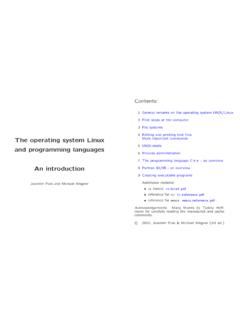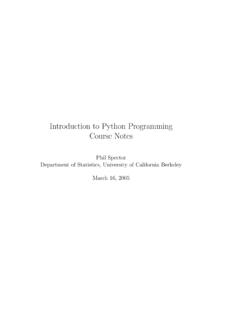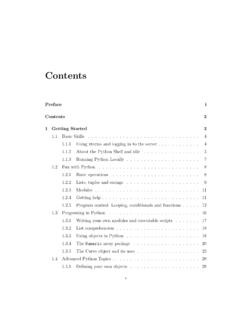Transcription of Advanced C Programming - ITCourseware
1 Advanced CProgrammingStudent Workbook 1994-1999 by ITCourseware , Inc. 8/992 Advanced C ProgrammingAdvanced C ProgrammingJeff HowellPublished by ITCourseware , 10333 E. Dry Creek Rd., Suite 150, Englewood, CO 80112 Special thanks to: Many instructors whose ideas and careful review have contributed to thequality of this workbook, including Brandon Caldwell, Denise Geller, Todd Gibson, RogerJones, Channing Lovely, and Danielle Waleri, and the many students who have offeredcomments, suggestions, criticisms, and 1994-1999 by ITCourseware , Inc. All rights reserved. No part of this book maybe reproduced or utilized in any form or by any means, electronic or mechanical, includingphoto-copying, recording, or by an information storage retrieval system, without permission inwriting from the publisher. Inquiries should be addressed to ITCourseware , Inc.
2 , 10333 E. DryCreek Rd., Suite 150, Englewood, Colorado, 80112. (303) brand names, product names, trademarks, and registered trademarks are the property oftheir respective owners. 1994-1999 by ITCourseware , Inc. 8/993 Advanced C ProgrammingContentsChapter 1 - Course Introduction .. 7 Course Objectives .. 9 Course 11 Suggested References .. 13 Chapter 2 - The C Development Evnironment .. 15 Chapter Objectives .. 17 The cc (1) Command .. 19 Include 21 Libraries .. 23 Exercises ..25 Chapter 3 - Basic and Derived Data Types in C .. 27 Chapter Objectives .. 29 Simple C Data Types .. 31 Integral Data 33 Floating Point 35 Derived Data Types .. 37 Array Data Types - Single and Multi-dimensional .. 39 Structure Data 41 Simple Pointer 43 Pointers to Structures / Multiple Pointers .. 45 Pointers to Functions.
3 47 The const 49 Bit Operators .. 51 Using 53 Exercises ..55 Appendix ..57 Chapter 4 - Functions: Calling, Passing, and Returning Values .. 59 Chapter Objectives .. 61 Anatomy of a Function .. 63 Parameter Passing - Pass by Value .. 65 1994-1999 by ITCourseware , Inc. 8/994 Advanced C ProgrammingParameter Passing - Pass by Reference .. 67 Exercises ..69 Chapter 5 - Standard I/O .. 71 Chapter Objectives .. 73 Standard I/O 75 File Access ..77 Formatted 79 String 81 File Positioning 83 Block 85 Exercises ..87 Chapter 6 - Low Level File I/O .. 93 Chapter Objectives .. 95 Standard I/O vs System 97 File Access ..99 Low Level I/O - Read and Write .. 101 File Positioning .. 103 Error 105 Exercises .. 107 Chapter 7 - Memory Allocation with malloc and calloc .. 109 Chapter Objectives .. 111 Dynamic Memory Allocation 113malloc(), calloc().
4 115realloc(), free().. 119 Example: Array of Pointers to Structures .. 121 Exercises .. 123 Chapter 8 - Memory Organization and Scope of Variables .. 125 Chapter Objectives .. 127 Command Line Arguments (argc, argv) .. 129 The Memory Layout of a C 131 The Stack Segment .. 133 The Heap 135 Exercises .. 137 1994-1999 by ITCourseware , Inc. 8/995 Advanced C ProgrammingChapter 9 - Data Structures: Linked Lists .. 139 Chapter Objectives .. 141 Problem - Array Limitations .. 143 Solution - Linked 145 Linked List - Formation .. 147 List Operations - Delete .. 149 Exercises .. 151 Appendix A .. 153 Debugging Techniques .. 155 Debugging Hints .. 157 Debugging with Pre-Processing Directives .. 163 Debug 165 Symbolic Debuggers .. 167 Appendix B .. 169 Coding from Pseudo Code .. 171 Project Header Files .. 173 Project Source Files.
5 175 Project Tracking (Bookkeeping) .. 177 Appendix C .. 179 Overview of the Make Utility .. 181 Using the Make Utility .. 183 Simple Makefile Commands .. 185 Appendix D .. 187 Preparing to Use a Debugger .. 189 Project Header Files .. 191 Project Source Files .. 193 Project Tracking (Bookkeeping) .. 195 Solutions - Advanced C Programming .. 197 Exercise Solutions .. 198 1994-1999 by ITCourseware , Inc. 8/996 Advanced C ProgrammingCourse Introduction 7 Chapter 1 1994-1999 by ITCourseware , Inc. 8/99 Chapter 1 - Course IntroductionNotes8 Advanced C Programming 1994-1999 by ITCourseware , Inc. 8/99 Course Introduction 9 Chapter 1 1994-1999 by ITCourseware , Inc. 8/99 Course ObjectivesContinue development of C Programming abilities by writing avariety of C understanding of variable attributes such as local, global,external and proficiency in writing programs that perform file andinteractive an understanding of how C implements data small scale applications that brings together the newlygained knowledge and C Programming 1994-1999 by ITCourseware , Inc.
6 8/99 Course Introduction 11 Chapter 1 1994-1999 by ITCourseware , Inc. 8/99 Course OverviewAudience: This course is for intermediate C programmers who needto design, implement, debug, and test C programs of : A beginning course in C. This course does not teachbasic C Programming . It is meant as a more Advanced course forpeople who have basic C Programming Materials:Student Environment:Individual C Programming 1994-1999 by ITCourseware , Inc. 8/99 Course Introduction 13 Chapter 1 1994-1999 by ITCourseware , Inc. 8/99 Suggested ReferencesKelley, A., and Pohl, I. 1998. A Book on C, Fourth Edition. Addison Wesley,Reading, MA. ISBN , B., and Ritchie, D. 1988. The C Programming Language, SecondEdition. Prentice Hall, Englewood Cliffs, NJ. ISBN , R., Leung, B. and Tondo, C. 1996. Data Structures and Program Design inC.
7 Prentice Hall, Englewood Cliffs, NJ. ISBN , R., and Agrawal, R. 1992. Programming in ANSI C. West Publishing Co.,St. Paul, MN. ISBN , W. 1992. Advanced Programming in the UNIX Environment. AddisonWesley, Reading, MA. ISBN C Programming 1994-1999 by ITCourseware , Inc. 8/99 The C Development Environment 15 Chapter 2 1994-1999 by ITCourseware , Inc. 8/99 Chapter 2 - The C Development EnvironmentNotes16 Advanced C Programming 1994-1999 by ITCourseware , Inc. 8/99 The C Development Environment 17 Chapter 2 1994-1999 by ITCourseware , Inc. 8/99 Chapter ObjectivesExplain what happens at the cc(1) the difference between include and library a library of object with external executable undefined symbol robust code using cc(1) command line C Programming 1994-1999 by ITCourseware , Inc. 8/99 The cc(1) command automatically invokes the four phases described on the followingpage.
8 Options to the cc(1) command allow you to stop the compilation after completingany particular phase. Use the -V option to display the phases of the compile an example, create the (infamous) program with the -V option to cc(1):$ cc -V convert to a function, then create which calls thefunction in Compile What happened? Whatadditional information must be supplied to cc(1)?INVESTIGATE:Read the man pages to see other options available to cc(1). What option is used to pre-process the source? Which option compiles but doesn t assemble the code? What are thenames of their corresponding output files?The C Development Environment 19 Chapter 2 1994-1999 by ITCourseware , Inc. 8/99 The cc (1) Commandcc(1) is typically a driver (1) executes the following programs:1.) C pre-processor (cpp)3.
9 Assembler (as)2.) C compiler (acomp or ccom)4.) Linker (ld)The C pre-processor looks for pre-processing directives to errors will not be caught output is typically placed in a file with suffix . are examples of C statements processed in this phase?The C compiler translates the pre-processed source into phase of the compiler catches syntax output is typically placed in a file with suffix . assembler turns the compiled source into a binary object resulting .o file is normally deleted if a single C source fileis compiled and then immediately option to cc(1) would you use to keep the .o file? (Wewill see many instances of why to keep the object file.)The link editor combines object files to produce an executable ld(1) command resolves external may also specify library files to search for objects.
10 (Wewill discuss libraries soon).The resulting executable, by default, is named option to cc(1) is used to override the defaultexecutable name?Notes20 Advanced C Programming 1994-1999 by ITCourseware , Inc. 8/99 Your code will be more portable and robust if you use command line options to specifypathnames to header files rather than hardcoding them in your source. Command lineoptions are usually placed within example, to include specified header files that exist in directories /home/denise/mydir and /home/fred/theirdir, use the following command line:cc -o fn -I/home/denise/mydir -I /home/fred/theirdirTo further clarify what an include file is, change the function hello_world to return thevalue of pi ( ). What modifications did you make to the function? Create thecorresponding header file, the following pre-processing directive to :#include < >Also, add the following statements to :float pi;pi = hello_world();printf ("Have a piece of %f\n", pi);Compile What happened?













